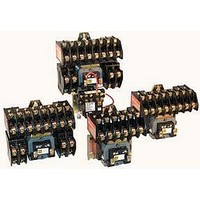8903LO80V02 SQUARE D, 8903LO80V02 Datasheet - Page 11

8903LO80V02
Manufacturer Part Number
8903LO80V02
Description
Lighting Contactor
Manufacturer
SQUARE D
Datasheet
1.8903LG20V01.pdf
(20 pages)
Specifications of 8903LO80V02
Relay Mounting
SMD
Coil Voltage Vac Nom
120V
Contact Current Max
30A
External Height
127mm
Continuous Load Current
30A
Peak Reflow Compatible (260 C)
No
External Width
143mm
External Depth
79mm
Operating Voltage
600VAC
Load Current Inductive
30A
Load Current Resistive
30A
No. Of Poles
8
Contact Configuration
8PST
Rohs Compliant
No
Lead Free Status / RoHS Status
Contains lead / RoHS non-compliant
1/98
Application of Lighting Contactors
Lighting contactors have evolved from the need for
more than just simple on-off manual control of lights.
Today’s requirements call for the development of new
and varied types of control. Often the application will
call for remote control of lighting from some distant
location. This control may or may not be in addition to a
master control station at a central location. Certain
applications include the use of automatic control by time
clocks or photelectric cells. Whatever the need may be,
applications are increasing, and lighting contactors are
designed to meet the ever-changing requirements.
Square D lighting contactors offer a time-proven design
for better electrical and mechanical performance. They
are used wherever reliable, convenient and economical
control of indoor and outdoor lighting is required. Typical
installations include:
• parking lots
• industrial plants
• office buldings
• theaters and auditoriums
• hospitals and institutions
Tungsten Lamp Loads
Tungsten lamps have a positive resistance
characteristic (resistance to the flow of electric current
increases as its operating temperature increases), thus
exhibiting an increase in resistance when the lamp is
energized. Therefore, these lamps have a high inrush
current of up to 18 times normal current resulting from
the low cold resistance of the tungsten. Examples of
tungsten lamps include incandescent lamps, iodine
lamps, quartz-iodine lamps and infrared lamps.
Ballast Lighting Loads
A ballast lighting load consists of electric discharge
(vapor) lamps. All types of vapor lamps possess a
negative resistance characteristic. The resistance
within the lamp decreases with an increase in current
and vice-versa. Without some form of current limiting
device in the electric circuit, the current would rise
quickly until lamp failure occured. This current limiting
element is known as the ballast. A ballast is an
impedance used to stabilize the current in a vapor lamp.
It has the property of increasing in resistance as current
through it increases and decreasing in resistance as
current decreases. Thus it tends to maintain a constant
current through it. Types of ballast lighting include high
intensisty discharge (HID) lamps – mercury vapor,
metal halide and high pressure sodium – and
flourescent lamps.
Resistance Loads
Square D lighting contactors are fully rated for
resistance loads up to 600 volts. They can be used on
resistance-type boilers, electric furnaces, electric water
heaters and snow melting cables and panels.
© 1998 Square D All Rights Reserved
• shopping centers
• stadiums
• airports
Motor Loads
These loads consist of motors having an inrush current,
or locked-rotor current, of approximately six times the
full-load current. Square D Type S lighting contactors
are fully rated for motor loads and have a horsepower
rating equal to the equivalent NEMA-Size motor
contactor.
Lighting Contactors for Energy Management
Lighting contactors should be an integral part of any
Energy Management System. They help conserve
energy consumption and reduce utility bills by providing
three types of control.
remote control of lighting. Cirucits can be turned on and
off from a number of remote locations in addition to a
master control station.
Selective switching is the control of one or more
individual lighting circuits, independent of the other
circuits. This design allows the potential for turning on
only the amount of lighting that is actually needed.
insure that lights will be turned off when not needed.
There are a number of devices that, when used with
lighting contactors, offer a convenient and reliable
method of automatically controlling lighting loads:
program time clock, photoelectric cell, programmable
controller and demand controller.
Installation of Lighting Contactors
For new installations, lighting contactors can either be
installed right in the lighting panelboard, or in their own
enclosure next to or remote from the panelboard.
In existing applications where the lighting control
system is being updated, lighting contactors can be
installed in their own enclosure next to a lighting
panelboard.
Compression Lugs
Square D Versa-Crimp compression
lugs for Type S lighting contactors,
100–800 ampers, are available factory
installed (Form Y157-4) or as a field
modification kit (see table on page 9).
They are suitable for both copper and
aluminum wire.
400 and 600 amperes devices) is
required for each line or load terminal.
Each Class 9999 Type AL hardware kit
includes mounting hardware for 3
terminals, line or load side.
lugs on a 300 ampere 3 pole device,
line and load sides, order six (6)
VCEL-060-12H1 lugs and two (2)
Class 9999 Type AL11 hardware kits.
One VCEL lug (one or two on the
EXAMPLE: To install compression
Lighting contactors offer both centralized and
They also offer selective switching of lights.
Lighting contactors can provide automatic control to
Application Data – Class 8903
11
















